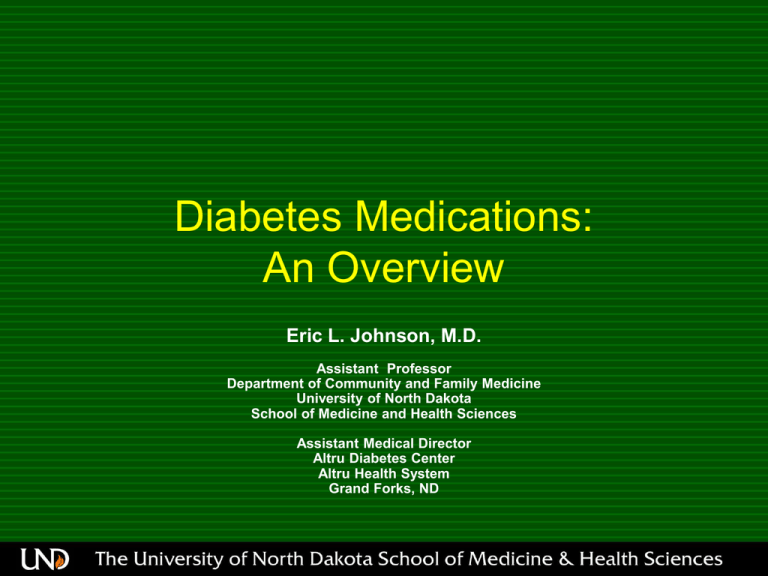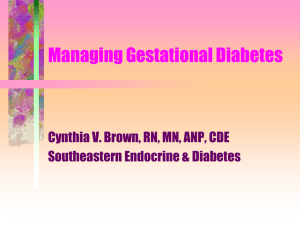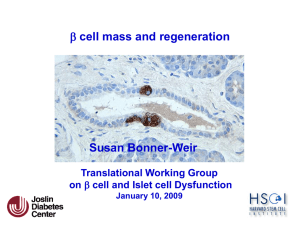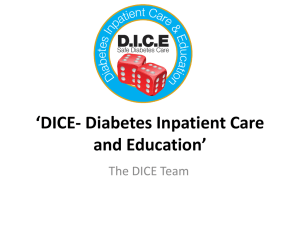
Diabetes Medications:
An Overview
Eric L. Johnson, M.D.
Assistant Professor
Department of Community and Family Medicine
University of North Dakota
School of Medicine and Health Sciences
Assistant Medical Director
Altru Diabetes Center
Altru Health System
Grand Forks, ND
Objectives
• Assess knowledge of usual diabetes
medications
• Implement proper medication use per
guideline management
• Improve knowledge of side effects and
contraindications of diabetes medications
Diabetes Mellitus
• Type 1: Usually younger, insulin at
diagnosis
• Type 2: Usually older, often oral agents at
diagnosis
• Type “1.5” (Latent Autoimmune),
mixed features
• Gestational: Diabetes of Pregnancy
U.S. Prevalence of Diabetes 2010
• Diagnosed: 26 million people—8.3%
of population (90%+ have Type 2)
• Undiagnosed: 7 million people
• 79 million people have pre-diabetes
CDC 2011
Diabetes Diagnosis
Category
FPG (mg/dL)
2h 75gOGTT
A1C
Normal
<100
<140
<5.7
140-199
5.7-6.4
>200
>6.5
Prediabetes 100-125
Diabetes
>126**
Or patients with classic hyperglycemic symptoms with plasma glucose >200
** On 2 separate occasions
Diabetes Care 34:Supplement 1, 2011
Natural History of Type 2 Diabetes
Obesity
IFG*
Uncontrolled
Hyperglycemia
Diabetes
Glucose (mg/dL)
350 –
Postmeal Glucose
300 –
250 –
Fasting Glucose
200 –
150 –
100 –
Relative Function (%)
50 –
250 –
Insulin Resistance
200 –
150 –
100 –
-cell Function
-Cell Failure
50 –
0–
-10
-5
0
5
10
Years of Diabetes
15
20
25
*IFG=impaired fasting glucose.
Copyright® 2000 International Diabetes Center, Minneapolis, USA. All rights reserved. Adapted with permission.
30
The Ominous Octet
Islet -cell
Decreased
Incretin Effect
Impaired
Insulin Secretion
Increased
Lipolysis
Islet a-cell
Increased Glucose
Reabsorption
Increased
Glucagon Secretion
Increased
HGP
Neurotransmitter
Dysfunction
Decreased Glucose
Uptake
Goals of Glucose Management
Targets for glycemic (blood sugar) control in
most non-pregnant adults
A1c (%)
Fasting (preprandial) plasma
glucose
Postprandial (after meal)
plasma glucose
ADA
AACE
<7*
≤6.5
70-130 mg/dL <110 mg/dL
<180 mg/dL
<140 mg/dL
*<6 for certain individuals
• American Diabetes Association. Diabetes Care. 2010;33(suppl 1)
• Implementation Conference for ACE Outpatient Diabetes Mellitus Consensus Conference Recommendations: Position Statement
at http://www.aace.com/pub/pdf/guidelines/OutpatientImplementationPositionStatement.pdf. Accessed January 6, 2006.
• AACE Diabetes Guidelines – 2002 Update. Endocr Pract. 2002;8(suppl 1):40-82.
A1C ~ “Average Glucose”
A1C
%
6
6.5
7
7.5
8
8.5
9
9.5
10
eAG
mg/dL
126
140
154
169
183
197
212
226
240
mmol/L
7.0
7.8
8.6
9.4
10.1
10.9
11.8
12.6
13.4
Formula: 28.7 x A1C - 46.7 - eAG
American Diabetes Association
Diabetes Medications
Diabetes Medications
• Many new medications in last decade
• Three main categories
– Oral agents (pills)- many different kinds old and new
– Insulin- newer, more modern insulins
– Newer, non-insulin injectable medications
• Choices allow individualization of treatment plan
• Different medications, different indications,
different situations
Glucose-lowering Potential of
Diabetes Therapies*
Treatment
FPG
HbA1C
Sulfonylureas
50-60 mg/dl
1-2%
Metformin
50-60 mg/dl
1-2%
a-Glucosidase Inhibitors (Precose)
15-30 mg/dl
0.5-1%
Repaglinade (Prandin)
60mg/dl
1.7%
Thiazolidinediones
40-60 mg/dl
1-2%
Gliptins (Januvia,Onglyza)
targets ppd
0.5 - 0.8%
*based on package insert data as monotherapy
Glucose-lowering Potential of
Injection Diabetes Therapies*
Treatment
FPG
HbA1C
Exenatide (Byetta)
targets ppd
1-1.5%
Liraglutide (Victoza)
targets ppd
1-1.5%
Pramlintide (Symlin)
targets ppd
1-2%
Insulin
Limited by
hypoglycemia
1.5-3.5%
*based on package insert data as monotherapy
ADA/EASD consensus algorithm
to manage type 2
Reinforce lifestyle interventions at every visit and check A1C every 3 months until A1C is <7% and
then at least every 6 months. The interventions should be changed if A1C is ≥7%.
Tier 1:
Well-validated core therapies
Lifestyle and MET
+ intensive insulin
Lifestyle and MET
+ basal insulin
At diagnosis:
Lifestyle
+
MET
Lifestyle and MET+ SUa
Step 1
Step 2
Step 3
Tier 2: Less well-validated studies
Lifestyle and MET
+ pioglitazone
No hypgglycemia
No
edema/CHF
Bone loss
Lifestyle and MET
+ GLP-1 agonistb
No hypoglycemia
No
Weight loss
Nausea/vomiting
aSU
other than glyburide or chlorpropamide.
bInsufficient
Lifestyle and MET
+ pioglitazone
+ SUa
Lifestyle and MET
+ basal insulin
clinical use to be confident regarding safety.
MET: metformin; SU: sulfonylurea. Nathan et al. Diabetes Care 2009;32(1): 193-203
Key Points of
Medication Selection in Type 2
• Metformin at diagnosis unless a
contraindication
• Second line agents- basal insulin or many
other meds
Oral Diabetes Medications
Sulfonylureas
• Oldest oral medications
• Stimulate pancreas to secret more insulin
• Effective, inexpensive
• Glyburide, Glipizide, Glimiperide
Caveats with Sulfonylureas
•
•
•
•
•
•
Hypoglycemia (particularly in elderly)
Premature B-cell exhaustion?
Caution in liver disease, renal disease
Weight gain
Rash
Avoid if anaphylactic to sulfa
Metformin
•
•
•
•
•
•
•
Improves insulin resistance
Reduced Hepatic Glucose production
Effective, inexpensive
Extremely low incidence of hypoglycemia
Weight neutral or weight loss
Positive effects on lipid profiles
Long term use may result in better CVD
outcomes
• Can be combined with virtually all other DM
meds
Caveats with Metformin
•
•
•
•
•
•
•
•
Liver Disease
Renal Disease
GI upset
Heavy Alcohol Use
Intravascular Dye Studies (IVP, Angio,etc)
CHF
Not for persons over 80
Can result in B12 deficiency
Thiazolidinediones (TZD’s)
• Pioglitazone (Actos)
• Rosiglitazone (Avandia)
• Improves insulin resistance
• Extremely low incidence of hypoglycemia
Caveats with TZD’s
•
•
•
•
•
CHF (or if hx/risk?)
Patients already dealing with edema
Potential weight gain
Renal disease-fluid overload
Current TZD’s rare liver disease, not
recommended in active liver disease
• Heart disease risk?
(Rosiglitazone-new restrictions)
Gliptins(DPP-IV)
• DPP-IV inhibitors
• Sitagliptin (Januvia)
• Saxagliptin (Onglyza)
• Oral agents
• Weight neutral or weight loss
• Can use with Metformin, Sulfonylurea, TZD, or
insulin (sitagliptin)
Gliptins’ Caveats, Benefits
Caveats:
• Hypoglycemia if used with sulfonyurea or
insulin
• Nausea, rash
Benefits:
Few drug interactions; can be renally dosed
“Niche” Drugs
• Colesevelam (Welchol)
- adjunct to lower A1c and LDL
- limited efficacy, cost
• Repaglinide (Prandin), Nateglinide (Starlix)
- may replace SU if sulfa allergy
- Prandin may be useful in CKD
• Acarbose (Precose), Miglitol (Glyset)
- limited efficacy, GI intolerance, cost
• Bromocriptine (Cycloset)
- limited efficacy? Will be marketed
• Salsalate
-older NSAID, may lower blood sugar,
no indication yet
Non-Insulin Injectable
Medications
Glucagon-like Peptide-1
(GLP-1)
•
•
•
•
•
•
Gut hormone
Stimulates pancreas to secret insulin
Suppresses glucagon action
Many target organs
Weight regulation
Caution in renal or hepatic impairment
GLP-1
•
•
•
•
•
Exenatide (Byetta) GLP-1 mimetic
Liraglutide (Victoza) GLP-1 analog
Both available in pen injectors (easy)
Modest weight loss
Combined with other agents except
DPP-IV inhibitors or insulin (exenatide has
basal insulin data)
GLP-1 Caveats
• Nausea, vomiting
• Pancreatitis
• Medullary thyroid carcinoma in rodents
(liraglutide)
• Hypoglycemia combined with sulfonyurea
Pramlintide-Synthetic Amylin
(Symlin)
• Amylin secreted by normal pancreas along
with insulin to regulate blood glucose
• Enhances Postprandial control. Used in
Type 1 and Type 2 patients
• Used as adjunct to insulin
• Available in pen injector
• Possible significant hypoglycemia
Combination Drug Therapy
• Consider early if failing monotherapy
• Generally additive or synergistic effects
• Triple or quadruple non-insulin drug
therapy
-limited benefit in many
-safe for many
• Insulin is often a better,more potent choice
Insulin Therapies
Insulin Therapy
• All Type 1 patients at diagnosis
• All type 2 patients will require insulin if
they live long enough
-7 to 10 years post diagnosis
-A1C >9%
-Function of many non-insulin meds
based on presence of native insulin
Beta-cell function declines as
diabetes progresses
Beta-cell function decline over time
100
Diagnosis
75
Beta-cell
function (%)
50
Beta-cell decline exceeds 50%
by time of diagnosis
IGT
Insulin
initiation
Postprandial
25
Type 2 Diabetes
Hyperglycemia
0
12
8
4
0
Years from diagnosis
Lebovitz H. Diabetes Rev 1999;7:139-153.
4
8
12
Insulin Therapy
• Modern insulins safer and
more predictable
• Most insulin types come in pen
injectors
• Pen injectors easy to use, to teach,
less cumbersome than vials/syringes
Rapid Acting Insulin
•
•
•
•
Aspart (Novolog)
Lispro (Humalog)
Glulisine (Apidra)
(Human Regular)
• Taken with meals and snacks
• “Bolus” insulin
Long-Acting Insulin
• Detemir (Levemir)
• Glargine (Lantus)
• Human NPH (N)
• Taken 1 or 2 times daily
• “Basal” insulin
Insulin Time Action Curves
140
Rapid (Lispro,Glulisine, Aspart)
Insulin Effect
120
100
Short (Regular)
80
Intermediate (NPH)
60
40
Long
(Detemir,Glargine)
20
0
0
2
4
6
8
Hours
10
12
14
16
18
20
adapted from R. Bergenstal, IDC
Basal Insulin in Type 2 Diabetes
•
•
•
•
•
•
Glargine (Lantus), Detemir (Levemir)
Good, potent add-on for improved A1C
Second line agent for many patients
A1C >9, diabetes longer than 5 to 7 years
AACE: ? Weight benefit with Detemir
Pen injectors easy
Basal Insulin in Type 2 Diabetes
• Some oral meds may be continued
-metformin, maybe TZD, maybe SU,
maybe gliptin (sitagliptin)
• Glargine (Lantus) or Detemir (Levemir)
started at 10 units at HS
• Increase 3 units every 3 to 5 days until
fasting blood sugars <110 (or <140)
• Most type 2 on 50-80+ units/day
Adding Bolus Insulin in
Type 2 Diabetes
•
•
•
•
Lispro (Humalog)
Aspart (Novolog)
Glulisine (Apidra)
Pen injectors
• Why is bolus insulin important in Type 2?
Fasting and Postprandial Glycemic Excursions
as a Function of A1C
80
Postprandial hyperglycemia
Contribution (%)
Fasting hyperglycemia
60
40
20
0
1
(<7.3)
2
3
4
(7.3–8.4) (8.5–9.2) (9.3–10.2)
Monnier L et al. Diabetes Care. 2003;26:881-885.
A1C (%) Quintiles
5
(>10.2)
Adding Bolus Insulin in
Type 2 Diabetes
• 1 injection basal/1 injection bolus
good 2 injection programbetter than split basal
• 90/10 rule (90% basal, 10% bolus)
• Start with largest meal of the day
• Add other meal doses later
• Usually stop TZD, always stop SU
• Easy with pens
Premix Insulins
• 70/30, 75/25, 50/50
• Combine R or rapid acting with NPH or an
“NPH-like” component
• Certain applications may be appropriate
• Limitation: change 2 insulins at once
Case Studies
Case #1
• 42 y/o Hispanic female with hx of GDM 6
years ago, term 10 lb 5 oz male infant
• Not seen for follow-up in 3 years
• FBS done at annual pap/px is 149
Does this patient have type 2 diabetes?
What next?
Case #1
• Diagnosis of diabetes generally requires
two abnormal values
• Patient at high risk for type 2
• GDM is a pre-diabetes condition
Repeat FBS three days later…….
Case #1
• Repeat FBS
135
• Dx: type 2 diabetes (FBS >126 on two
separate occasions)
• What should be done next for this patient?
Case #1
• Patient had tubal ligation after last delivery
• Start metformin 500mg BID, advance to
850-1000 mg BID
• Most newly-diagnosed patients should
start metformin (current ADA
recommendation)
Case #1
• Diabetes Educator and Dietician
• SBGM with appropriate targets
• Check fasting lipids, monitor Blood
Pressure
Case Study#2
• 54 y/o white male
• Diagnosed with type 2 diabetes after 2
fasting blood sugars of 154 and 142
• Also has high blood pressure and
cholesterol disease (common in type 2)
Case Study #2
• Metformin 500 mg prescribed twice daily,
titrated to 1000mg BID
• ASA 81 mg daily
• Referred to Diabetes Educator and
Dietician for meal planning
• Recommend developing graduated
exercise plan (exercise prescription)
• Six months after diagnosis, A1C = 6.8%
(target <7%)
Case Study #2
• Three years later, patient’s A1C has risen
to 8.4% (target <7%)
• Blood pressure and cholesterol effectively
treated
• Now what?
Case Study #2
• Choices include
– Adding a basal insulin once daily
– Adding any other oral agent
– Adding exenatide twice daily or liraglutide
once daily
• Any of these are good choices
• Choice may be made on individual factors
Case Study #2
• Patient chose additional oral agent
(sitagliptin), but others would be OK
• A1C:
6 months later = 7.4% (target <7%)
3 years later = 8.1% (target <7%)
Now what?
Case Study #2
• Sitgliptin, metformin continued
• Basal insulin started with titration
• Eventually added bolus insulin with largest
meal (90/10 rule)
• Likely will add bolus with other meals
over time
Medication Combinations
•
•
•
•
•
Sulfonylureas: Virtually any in type 2
Metformin: Virtually any in type 2
TZD: Virtually any in type 2
Gliptins: metformin, TZD, insulin (sitagliptin)
Insulin: metformin, TZD, sulfonylurea, amylin,
sitagliptin
• Amylin: only in insulin regimens
• Exenatide/Liraglutide: metformin, sulfonyureas,
TZD
Medication Indications
• Type 1 Diabetes: Insulin, amylin (amylin
only in combination with insulin)
• Type 2 Diabetes: All oral agents,
exenatide, liraglutide, amylin, insulin
(amylin only in combination with insulin)
• Prediabetes: none (yet), case by case,
i.e., PCOS
Summary
•
•
•
•
Diabetes is common
Understand Medications and Indications
Type 1 diabetes: Insulin regimen (pumps)
Type 2 diabetes: Lots of choices, but
nearly all will need insulin eventually
Acknowledgements
• North Dakota Department of Health, Karalee Harper
• Centers for Disease Control
• Office of Continuing Medical Education, UNDSMHS,
Mary Johnson
• Department of Family and Community Medicine,
UNDSMHS, Melissa Gardner
• Brandon Thorvilson, UNDSMHS IT
• Disclosure: Novo Nordisk Speaker’s Bureau
Contact Info/Slide Decks/Media
e-mail
eric.l.johnson@med.und.edu
ejohnson@altru.org
Phone
701-739-0877 cell
Slide Decks (Diabetes, Tobacco, other)
http://www.med.und.edu/familymedicine/slidedecks.html
iTunes Podcasts (Diabetes) (Free downloads)
http://www.med.und.edu/podcasts/ or iTunes>> search UND Medcast
soon)
WebMD Page: (under construction)
http://www.webmd.com/eric-l-johnson
Diabetes e-columns (archived):
http://www.ndhealth.gov/diabetescoalition/DrJohnson/DrJohnson.htm
(updated









